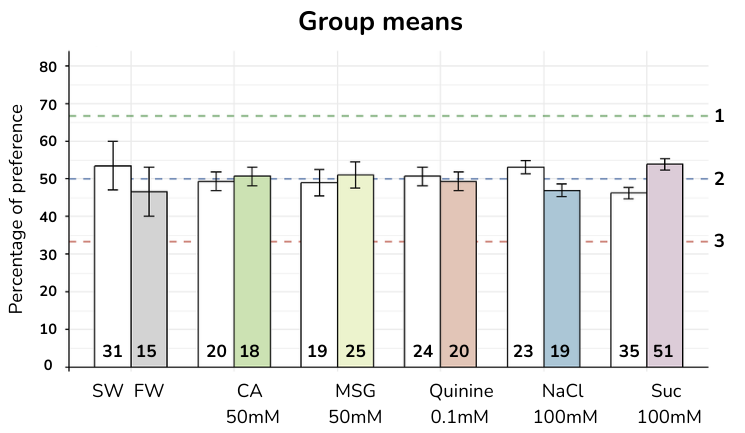For each animal, the total amount of liquid consumed from each bottle was recorded, summed for all trials with a given combination of stimuli and converted into percentages.
An animal was considered to significantly prefer one of the two stimuli if:
- It reached the preference criterion of 66.7 %.
- Consumed more from the bottle containing the preferred stimulus in at least 8 out of 10 trials (binomial test, p-value < 0.05).
Here are presented the results of the 3 manatees combined for each test.
Step 1

Step 2

Step 3

Legend of the graphs
Each figure shows the relative taste preferences of the three manatees as a group, given a choice between the control (seawater (SW) for steps 1 and 2, and freshwater (FW) for step 3), and between solutions of different concentrations of the taste substances used (citric acid (CA) for sour, monosodium glutamate (MSG) for umami, quinine hydrochloride for bitter, sodium chloride (NaCl) for salty, and sucrose (Suc) for sweet), all of which were diluted in seawater for steps 1 and 2, and in freshwater for step 3 (± SD). Each bar represents the mean value (± SD) across all trials performed by the three animals combined. Each white bar represents the preference for the control and each coloured bar represents the preference for the alternative stimulus. The number inside each bar indicates the total number of trials in which the animals drank more of the respective stimulus compared to the other stimulus. Dotted lines indicate 66.7 % the criterion of preference (1), 50 % the chance level (2) and 33.3 % the criterion of aversion (3), respectively.
The manatees as a group did not show a significant preference for or a significant avoidance of any stimulus. They also did not show a preference for freshwater over seawater. This was true both with regard to the ratio, and with regard to the calculated percentage of a given liquid consumed. This was also true at the individual levels.
Let’s discuss now!